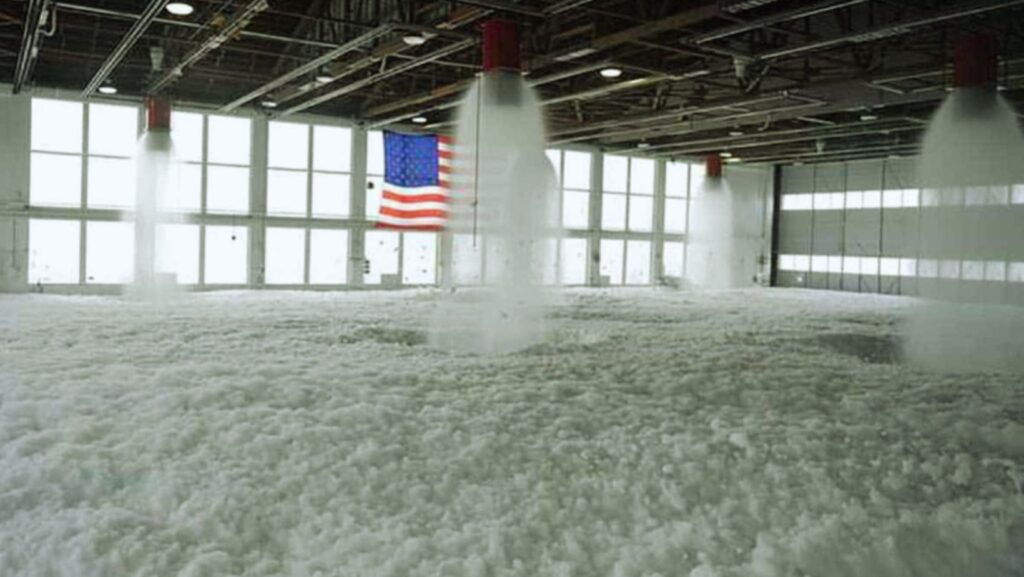Firefighters are our everyday heroes, bravely rushing into danger to protect our communities. But did you know that some of the equipment they rely on might be linked to health risks?
Aqueous film-forming foams (AFFF), a go-to firefighting tool for decades, have recently raised concerns due to certain chemicals they contain. If you’ve been a firefighter exposed to AFFF and are experiencing health problems, you may be wondering about your legal options.
Before filing an AFFF lawsuit, it’s important to understand what makes these foams potentially hazardous and the potential consequences of exposure to them. In this section, we’ll explore the dark side of PFAS and how they make firefighting foam toxic.
Aqueous Film-Forming Foams (AFFF) and PFAS
AFFF is a type of foam used to extinguish fires fueled by flammable liquids, such as gasoline or jet fuel. It works by creating a thin film on the surface of the fuel, cutting off the oxygen supply and smothering the fire.
While effective at fighting fires, AFFF contains a class of chemicals known as per- and poly-fluoroalkyl substances (PFAS). These man-made chemicals are known for their ability to repel both water and oil, making them ideal for use in firefighting foams. However, their unique chemical properties also make them highly persistent in the environment and potentially harmful to human health.
The Dark Side of PFAS
PFAS has been linked to a wide range of health issues, including reproductive and developmental problems, liver and kidney damage, immune system disorders, and certain types of cancer. They are also known to accumulate in the human body over time, as they do not break down easily.
One specific type of PFAS, perfluorooctanoic acid (PFOA), has a half-life of approximately 3.8 years in humans, meaning it takes that long for the body to eliminate half of the amount present. This means that even low levels of exposure can lead to long-term accumulation and potential health issues.
In addition to health concerns, PFAS have also been found to persist in the environment, contaminating water sources and soil. This has led to widespread contamination of drinking water supplies and potential harm to wildlife.
Regulatory Landscape and Firefighting Foam
The historical use of PFAS-containing AFFF has undergone significant scrutiny due to the growing awareness of their toxicity. Initially, these firefighting foams were lauded for their effectiveness in extinguishing difficult fires, particularly those involving flammable liquids.
However, as evidence of PFAS’s adverse health and environmental impacts mounted, regulatory bodies and environmental organizations began pushing for change. This led to a phase-out of specific PFAS chemicals, such as perfluorooctanoic acid (PFOA) and perfluorooctanesulfonic acid (PFOS), in firefighting foam formulations.

Regulatory pressure, spearheaded by agencies like the Environmental Protection Agency (EPA) in the United States and similar entities worldwide, has significantly curtailed their use.
In response to these regulatory and environmental health concerns, the development of fluorine-free firefighting foams (F3) emerged. These F3 alternatives represent a safer solution, minimizing the potential for PFAS exposure and environmental contamination.
This shift underscores a critical turn in firefighting technology, balancing fire suppression needs with health and environmental stewardship.
Legal Implications of PFAS Exposure
Firefighters, who have long relied on Aqueous Film-Forming Foams (AFFF) in their line of duty, are now facing the looming specter of health concerns purportedly linked to PFAS exposure.
This exposure, mainly through training exercises and actual firefighting operations, could have serious health ramifications ranging from thyroid cancer to immune system disorders. Furthermore, the persistence of PFAS in the human body complicates the scenario, making even minimal exposures potentially harmful over time.
Given these health risks, firefighters, both active and retired, may consider pursuing legal recourse. Legal claims might be predicated on various grounds:
● Negligence by the manufacturers of AFFF for not adequately warning of the risks associated with PFAS.
● Product liability for designing, manufacturing, and selling a harmful product.
● Workplace safety violations, holding fire departments or governmental bodies accountable for providing unsafe working conditions.
In pursuing legal claims, there are several crucial considerations:
● Burden of Proof: Plaintiffs must demonstrate that exposure to PFAS substantially contributed to their medical condition.
● Causation: Establishing a direct link between PFAS exposure and specific health outcomes is crucial.
● Additionally, firefighters may opt for class-action lawsuits if numerous individuals have been similarly affected, streamlining the litigation process and potentially leading to substantial settlements or judgments.
Potential legal actions by firefighters against AFFF manufacturers or other entities require navigating complex legal landscapes, including understanding the statute of limitations and potentially challenging legal defenses.

Despite these hurdles, successful litigation could offer compensation for medical expenses, lost wages, and other related costs, emphasizing the significance of legal awareness and advocacy for those exposed to PFAS.
Moving Forward: Safer Alternatives and Risk Mitigation
The shift towards fluorine-free firefighting foams represents an essential step in mitigating the risks of PFAS exposure. However, there are still concerns regarding the potential environmental impacts of these alternatives.
To address these concerns, manufacturers and regulatory bodies must continue to prioritize research and development of safer and more sustainable options for fire suppression. This could include exploring biodegradable foams or alternative methods of firefighting.
Additionally, implementing strict regulation and oversight in the production, use, and disposal of PFAS-containing products is crucial to preventing further contamination of our environment and water sources.
It is also essential for individuals to educate themselves on PFAS and take steps to reduce their exposure, such as avoiding products that contain these chemicals. By working together, we can strive towards a safer and healthier future for ourselves and our environment.


More Stories
Unlock The Magic: Crafting An Unforgettable Wedding Photobook Experience
Hobbies To Take Up In 2025
Creative Problem Solving Using Design Thinking